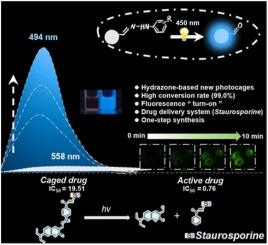传统腙类类似物作为超高光解效率光笼在动态生物成像和前药构建中的创新应用
IF 3.7
1区 化学
Q1 CHEMISTRY, ANALYTICAL
引用次数: 0
摘要
在本研究中,我们探索了传统腙类似物SA和LG系列作为一类新型光笼的新应用,它们通过一步反应成功地将各种苯肼与香豆素和三苯胺(TPA)的两种醛偶联而成。在450 nm照射下,这些化合物表现出显著的光解行为,转化率高达99.0%。值得注意的是,这种超高的光解效率可能代表了迄今为止报道的最高转化率。同时,我们提出了基于关键中间体和最终产物识别的光氧化过程的光解机制。在细胞研究中,释放过程在MCF-7癌细胞中实时可视化,荧光强度随着照射时间的增加而增加,证明了这些基于腙的光笼在生物成像应用中的潜力。此外,通过将其中一个LG光笼与staurosporine类似物偶联,我们开发了光控给药系统(DDS), LG- sts,也证明了有效的光解。staurosporine类似物可以通过渐进荧光增强和细胞水平抗癌活性增加25倍来释放和可视化。总之,我们的研究强调了基于腙的光笼在荧光生物成像和光控药物释放方面的巨大潜力,为先进的DDS开发提供了一个有希望的平台。本文章由计算机程序翻译,如有差异,请以英文原文为准。

Innovative application of conventional hydrazone analogues as photocages with ultrahigh photolysis efficiency for dynamic bioimaging and prodrug construction
In this study, we explore a novel application of conventional hydrazone analogues SA and LG series as a new class of photocages, which are successfully developed by coupling various phenylhydrazines with two aldehydes of coumarin and triphenylamine (TPA) via one-step reaction. Under 450 nm irradiation, these compounds exhibit significant photolysis behavior, achieving impressive conversion rate of up to 99.0 %. Notably, this ultrahigh photolysis efficiency may represent the highest conversion rate reported to date. Meanwhile, we propose the photolysis mechanism identified as a photooxidation process based on the identification of key intermediates and final products. In cellular studies, the uncaging process is real-time visualized in MCF-7 cancer cells, as evidenced by fluorescence intensity increase over irradiation time, demonstrating these hydrazone-based photocage spotential for bioimaging applications. Moreover, by conjugating one of the LG photocage with a staurosporine analog, we develop a photo-controlled drug delivery system (DDS), LG-STS, which also demonstrate efficient photolysis. The staurosporine analog can be released and visualized via a progressive fluorescence enhancement and a 25-fold increase in anticancer activity at cellular level. Overall, our study highlights the significant potential of hydrazone-based photocages for applications in fluorescent bioimaging and photo-controlled drug release, providing a promising platform for advanced DDS development.
求助全文
通过发布文献求助,成功后即可免费获取论文全文。
去求助
来源期刊

Sensors and Actuators B: Chemical
工程技术-电化学
CiteScore
14.60
自引率
11.90%
发文量
1776
审稿时长
3.2 months
期刊介绍:
Sensors & Actuators, B: Chemical is an international journal focused on the research and development of chemical transducers. It covers chemical sensors and biosensors, chemical actuators, and analytical microsystems. The journal is interdisciplinary, aiming to publish original works showcasing substantial advancements beyond the current state of the art in these fields, with practical applicability to solving meaningful analytical problems. Review articles are accepted by invitation from an Editor of the journal.
 求助内容:
求助内容: 应助结果提醒方式:
应助结果提醒方式:


